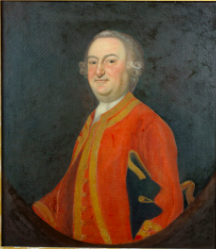Bay of Fundy Campaign (1755)
| Bay of Fundy Campaign | |||||
|---|---|---|---|---|---|
| Part of French and Indian War | |||||
 John Winslow, British commander |
|||||
|
|||||
| Commanders and leaders | |||||
|
John Winslow Captain Alexander Murray |
Charles Deschamps de Boishébert et de Raffetot Joseph Broussard |
||||
| Units involved | |||||
| 40th Regiment of Foot |
Acadia militia Wabanaki Confederacy (Maliseet militia and Mi'kmaq militia) |
||||
The Bay of Fundy Campaign occurred during the French and Indian War (the North American theatre of the Seven Years' War) when the British ordered the Expulsion of the Acadians from Acadia after the Battle of Fort Beauséjour (1755). The Campaign started at Chignecto and then quickly moved to Grand Pré, Rivière-aux-Canards, Pisiguit, Cobequid, and finally Annapolis Royal. Approximately 7,000 Acadians were deported to the New England colonies.
The British Conquest of Acadia happened in 1710. Over the next forty-five years the Acadians refused to sign an unconditional oath of allegiance to Britain. During this time period Acadians participated in various militia operations against the British, such as the raids on Dartmouth, Nova Scotia. The Acadians also maintained vital supply lines to the French Fortress of Louisbourg and Fort Beauséjour. During the French and Indian War (the North American theatre of the Seven Years' War), the British sought both to neutralize any military threat the Acadians posed, and to interrupt the vital supply lines they provided to Louisbourg, by deporting them from Acadia. Prior to the expulsion, the British retrieved the Acadians' weapons and boats in the Bay of Fundy region and arrested their deputies and priests.
After the fall of Fort Beauséjour (1755), the first wave of the expulsion of the Acadians began in the region of Chignecto. Under the direction of Colonel Robert Monckton, on August 10, Lieutenant-Colonel John Winslow seized four hundred unsuspecting men who were at Fort Cumberland (formerly Fort Beauséjour). He also imprisoned 86 Acadians within Fort Lawrence. The number of prisoners was one third of the men of the region; many of the others fled the region. The prisoners were kept in the fort until transports arrived to deport them. The wives and children joined them upon departure.
...
Wikipedia
